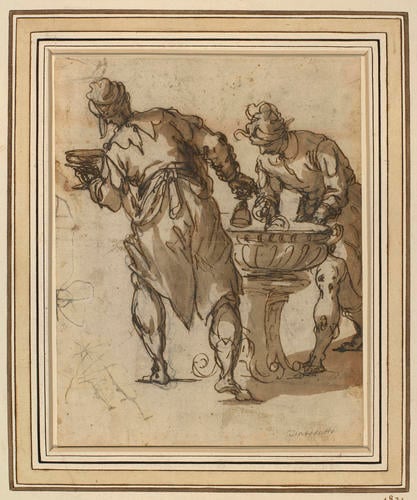-
1 of 253523 objects
Two men serving wine c. 1600-30
Pen, ink and wash, graphite, white heightening on buff paper | 21.5 x 16.9 cm (sheet of paper) | RCIN 904824

Alessandro Maganza (1556-1640)
Two men serving wine c. 1600-30
-
A drawing in pen, ink and wash, over pencil under drawing, of two men serving wine. White heightening has been applied in an attempt to efface the pen lines on the left-hand side of the sheet. Inscribed in pencil in a later hand in the lower right corner: ‘Tintoretto’, and stamped with a George V blind stamp.
Executed in expressive pen lines, this drawing of two men filling glasses from a wine bowl was produced by Alessandro Maganza (1556 – c.1630). Maganza sketched the figures in light graphite then built up his design, reworking the pose and embellishing details in thick pen strokes.
Maganza trained under his father Giovanni Battista Maganza (1513–86) and studied in the workshop of Giovanni Antonio Fasolo (1530–72), who was a follower of Veronese. Following Fasolo’s death, Maganza spent four years in Venice where he was strongly influenced by the works of Jacopo Tintoretto, Palma Giovanne and Veronese. On his return to Vicenza in 1576, Maganza established a large family workshop. He predominantly produced religious paintings, such as his Passion cycle for the Cappella del Sacramento in Vicenza Cathedral.
Maganza’s assimilation of the style of Venetian artists has led to his drawings being misattributed, as was the case with this sheet. Mario di Giampaolo identified this as a work by Maganza, and comparison with other drawings by Maganza support this attribution. The Metropolitan Museum, New York holds a study of a male figure (inv. no.: 1975.1.249) who stands in a similar pose to the figure on the left of this sheet and exhibits the same distinctive V shaped strokes used to indicate calf muscles. The sheet also bears clear stylistic similarities to Maganza’s drawing of the Banquet of Herod in the Prado, Madrid (inv. no: D001559), particularly in the loose, rounded lines used to depict headwear and in the rendering of shadows in brown wash. Given the similarities in style and content it is possible that thepresent sheet could have been connected to this drawing.
Provenance
Royal Collection by c. 1810; listed in George III's 'Inventory A,' c. 1800-20, p.85: ‘Tintoretto’.
-
Creator(s)
-
Medium and techniques
Pen, ink and wash, graphite, white heightening on buff paper
Measurements
21.5 x 16.9 cm (sheet of paper)
Category
Object type(s)